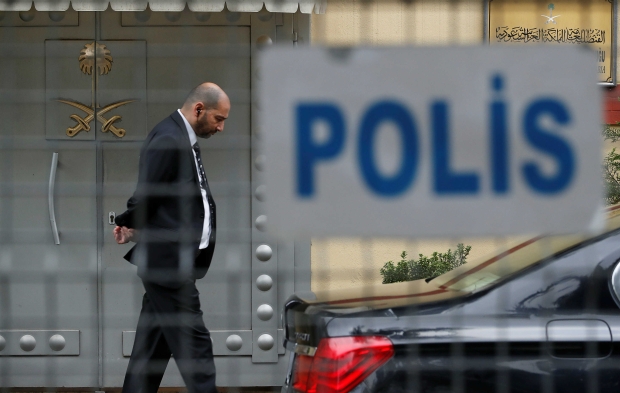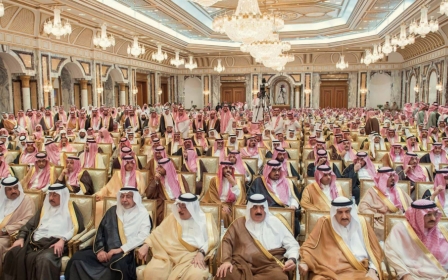Analysis: Saudi story on Khashoggi killing riddled with holes and contradictions

As hard as it tries, Saudi Arabia's version of Jamal Khashoggi's death just isn't adding up.
Seventeen days after the journalist went missing, Riyadh admitted its operatives killed the critic of the Saudi government in its Istanbul consulate.
But as Saudi officials scramble to flesh out Riyadh's latest line on the killing, unexplained discrepancies with Turkey's version of events, along with fresh evidence sourced from Turkish authorities and elsewhere, have emerged.
On Friday night, the Saudi attorney-general said Khashoggi died accidentally in a fist-fight, and his death was covered up without the knowledge of Crown Prince Mohammed bin Salman.
Yet, five well-placed sources from various Turkish authorities - some of whom say they have listened to an audio recording of Khashoggi's death - have detailed a quite different narrative to Middle East Eye.
The Turkish sources have strong, mounting evidence outlining the series of events that led to Khashoggi's premeditated murder and its cover-up, they have said.
The evidence is not restricted to audio and video recordings alone.
Below are six key areas where the Saudi story contradicts the evidence and Turkish version:
1. Heated exchanges
According to the Saudi statement on Friday, a team of Saudi officials went to Istanbul to meet Khashoggi at the consulate on 2 October to convince the government critic to return home.
He had been living in self-imposed exile since 2017, after falling out with the Saudi royal court.
An anonymous Saudi official has told the Reuters news agency that the team intended to take him to a safe house in Istanbul and pressure him into returning to Saudi Arabia. If Khashoggi still refused to fly back to Riyadh after a few days, the official said, he would have been freed.
General Maher Abdulaziz Mutrib, an intelligence officer often seen around the crown prince, told Khashoggi he was here to kidnap him, the official said. According to the Saudi version, this is when Khashoggi began to scream.
However, MEE understands that Khashoggi was attacked almost the moment he stepped into the consul-general's office. Pleasantries were exchanged momentarily, before two men burst into the room and seized Khashoggi.
There was no heated talking or interrogation.
2. Account of the death
"The intention was not to kill him," the anonymous Saudi told Reuters.
According to the official's version of events, Khashoggi died as he was placed in a chokehold during a panicked fist-fight that broke out once the journalist realised he'd been set up.
"If you put someone of Jamal's age in this position, he would probably die," the Saudi official said.
Another anonymous Saudi official told the New York Times: "That is how he died. It didn’t last that long."
Yet as MEE detailed previously, Turkish authorities say Khashoggi died a brutal death.
Khashoggi took seven minutes to die, MEE revealed, and the Saudi team that confronted him began to dismember the critic on a desk in the consul-general’s study before he had even died.
The cause of Khashoggi's death was not accidental asphyxiation, MEE understands, but a deadly injection of drugs, likely morphine.
3. The pathologist and the bone saw
Riyadh officially insists that the 15-man team sent to Istanbul to ambush Khashoggi was there only to question him and convince him to return home.
However, the Saudis have not revealed why, if the team was in Istanbul to interview him alone, no interrogation specialists were present, nor officials from the police or interior ministry.
Since the rise of Crown Prince Mohammed bin Salman, Saudi Arabia has practiced a campaign of forced rendition on dissidents abroad.
The anonymous Saudi official that spoke to Reuters detailed this policy with documentary evidence, suggesting Khashoggi was intended to suffer the same fate.
Kidnap may explain the presence of several military officers. But it does not address the presence of Salah Muhammad al-Tubaigy, the kingdom's leading forensic pathologist.
Tubaigy was enlisted due to his expertise in covering up evidence in crime scenes, Saudi officials have said.
One official told the New York Times that Tubaigy was present in case the operation needed to be aborted and fingerprints needed to be removed.However, Tubaigy's true talent, MEE understands, lies in carrying out lightening-quick autopsies.
It was Tubaigy who began to dismember Khashoggi's body, using a bone saw that the Saudis say was not present, but that Turkey insists was flown to Istanbul with the Saudi team.
As the forensic pathologist began to cut Khashoggi up, he put on earphones and began to listen to music.
"When I do this job, I listen to music. You should do [that] too," Tubaigy was recorded as saying, a source told MEE.
The sheer speed with which Tubaigy cut up Khashoggi's corpse apparently displeased the rest of the team, who were unable to wrap up the body parts fast enough, a source close to the investigation told MEE.
4. The bodyguard
Mohammed bin Salman, the heir to the Saudi throne commonly known as MBS, has claimed no knowledge of the operation.
In response to the scandal, he has dismissed two of his closest lieutenants, General Ahmed al-Assiri, deputy head of the intelligence services, and Saoud al-Qahtani, a top aide.
However, as MEE revealed, seven of the team sent to Istanbul are members of the crown prince's security and protection detail.
Mutrib, the intelligence officer seen around MBS, coordinated the operation, MEE understands.
A Turkish source close to the investigation told MEE on Sunday that the Saudis are scrambling to explain Mutrib's presence in the Istanbul team, so as not to implicate the crown prince.
"They are claiming that Assiri asked Qahtani for names of people who knew Khashoggi and could persuade him to come back, with Qahtani suggesting Mutrib because they worked together in London," the source said.
"This does not hold any water. Mutrib was one of four men taken from the crown prince's personal security detail."
5. The body and the carpet
Saudi Arabia says it is not aware of the body's whereabouts. According to the Saudi version of events, Khashoggi was not dismembered, and his body was instead rolled into a carpet.
On Sunday, a Turkish source denied this to MEE. "They cut the body into pieces, 15 pieces, according to the Turkish officer heading the investigation unit. They did not roll anything up in anything," the source said.
They cut the body into pieces, 15 pieces, according to the Turkish officer heading the investigation unit. They did not roll anything up in anything
- Turkish source
The Saudis say that Khashoggi's corpse was handed to a "local collaborator" to dispose of. The collaborator is not thought to be a Saudi national, MEE understands.
In recent days, the Turkish authorities have been searching for Khashoggi's remains. They have searched the consulate, the consul-general's house, a small grove adjacent to the residence and woodland on the city's outskirts.
Investigators are also searching the town of Yalova, located some 90km from Istanbul.
"The carpet story is another lie to cover up the fact they will never reveal details of where the body is," the Turkish source said.
6. The cover-up
In an attempt to conceal Khashoggi's killing, one of the Saudi team put on the journalist's clothes, glasses and Apple watch, the anonymous Saudi official told Reuters.
The official said the impersonator then walked out the back door to make it look as if Khashoggi left the building, and disposed of his belongings in the central Sultanahmet district.
The carpet story is another lie to cover up the fact they will never reveal details of where the body is
- Turkish source
Yet Turkish sources told MEE on Sunday that they were aware of the plan to impersonate Khashoggi, but that it was not carried out.
"The squad was not convinced that he looked the same as Khashoggi," the source said. It was at this point that the Saudis decided to remove the hard drives of all the CCTV cameras in the consulate.
MEE has learned that the Saudi team did not panic when Khashoggi was killed.
Instead, the Saudis parceled up his remains, placed them in a van, and then proceeded to the consul-general's house 500 metres away for dinner. It was a meal to celebrate a mission accomplished.
Middle East Eye propose une couverture et une analyse indépendantes et incomparables du Moyen-Orient, de l’Afrique du Nord et d’autres régions du monde. Pour en savoir plus sur la reprise de ce contenu et les frais qui s’appliquent, veuillez remplir ce formulaire [en anglais]. Pour en savoir plus sur MEE, cliquez ici [en anglais].







